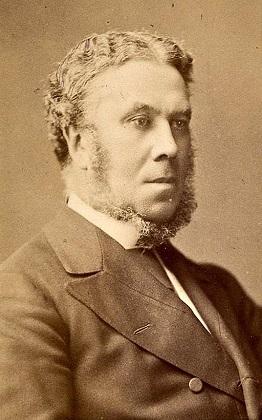
Peter McLagan, c 1900
Image credit: Unknown author, Public domain, via Wikimedia Commons
Peter McLagan (1823-1900), was a British Liberal Party politician who was the Member of Parliament (MP) for Linlithgowshire, in the central belt of Scotland, for nearly 30 years, from 1865 to 1893. Notably, he is Scotland’s first and, to date, only black MP. He was also Scotland’s longest serving MP during the reign of Queen Victoria. To mark Black History Month, we have chosen to investigate his life, family background and achievements using National Records of Scotland’s (NRS) Scotland's People and published resources.
McLagan was born on New Year’s Day 1823 in Demerara, the capital of British Guyana (now Guyana), which is situated on the north coast of South America, east of Venezuela. McLagan’s parents were Peter (or Patrick) McLagan (1774-1860), a wealthy plantation owner, and a local black Guyanese woman. He also had an older brother called John.
British Guyana was a colony and its main exports were rum and molasses. McLagan’s father and Samuel Sandbach co-owned two large coffee plantations, the Coffee Grove and Caledonia estates. They were partners in Sandbach, Tinne & Co., a company based in Liverpool, with Scottish connections that owned ships and plantations in the West Indies. (Coffee Grove & Caledonia [ British Guiana | Demerara ]', Legacies of British Slavery database, [accessed September 2022])
McLagan’s father retired in 1821 but remained in Demerara until at least 1825. At some point between 1825 and 1827, McLagan left British Guyana with his father and brother, John, for a new life in Scotland. In 1827, McLagan’s father married Elizabeth Hagart Stewart (1794-1833), at New Street Chapel in Edinburgh.
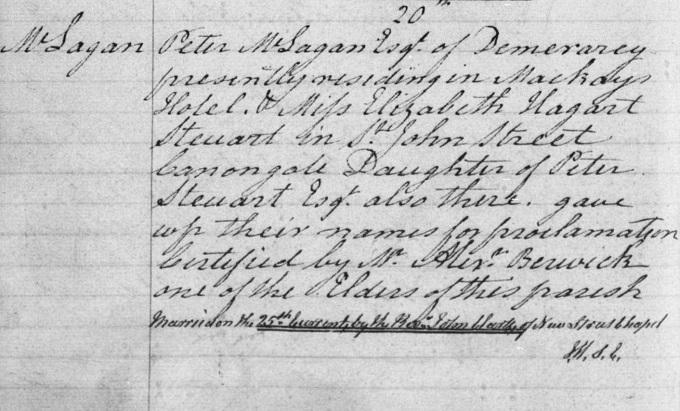
Proclamation of Peter McLagan and Elizabeth Hagart Steuart [Stewart] on 20th April 1827. The couple were married on 25th April at New Street Chapel, Edinburgh.
Crown copyright, NRS, Old Parish Register of Marriages, 685/3/280, page 320
Following the emancipation of enslaved people by the UK Government in the 1830s, McLagan’s father and Samuel Sandbach, his co-partner, received just over £21,480 compensation in 1836 for the legal emancipation of 407 enslaved people. ('British Guiana 2512 (Coffee Grove & Caledonia)', Legacies of British Slavery database, [accessed September 2022]. According to The National Archives Currency Converter, this amount in 1840 was worth approximately £1,297,789 in 2017. In 1842, McLagan’s father purchased the Calderbank and Pumpherston estates in Mid Calder, West Lothian.
During this time in Scotland, McLagan and his brother John were both educated at Tillicoultry School in Clackmannanshire, and attended the University of Edinburgh. John graduated in medicine in 1836 and became a surgeon in Demerara, where he died on 11th November 1850.
Using the records on the Scotland's People website, we first find McLagan in the 1841 census for Edinburgh. He is enumerated, aged 18, living at 77 Great King Street in Edinburgh’s New Town, together with his father, Peter, aged 65; Janet McLagan, his cousin, aged 25, and John Duff, a merchant, aged 25. The column on the right-hand side of the page indicates that they were not born in the county as denoted by the ‘N’ for ‘No’. According to the Old Parish Registers of births, McLagan’s father was born in Moulin, Perthshire, in 1774 (NRS, Old Parish Registers of Births, 834/10, page 35).
Also present in the household, are three female servants (abbreviated ‘FS’): Ann Ballantine, aged 30; Margaret Mowbray, aged 25, and Ann Elliot, aged 19. They were all born in the county as denoted by the ‘Y’ for ‘Yes’ in the column on the right-hand side of the page. In the 1841 census, ages are rounded down to the nearest five for anyone over 15 years of age. McLagan’s father is enumerated aged 65, but he was born in 1774. However, his son’s correct age of 18 is given.
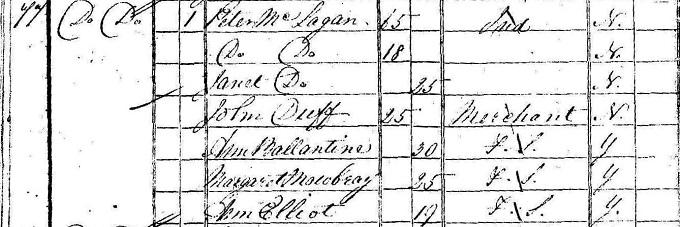
Detail of the entry for Peter McLagan, aged 18, and his father’s household in the 1841 census for Edinburgh.
Crown copyright, NRS, 1841/685/1/164, page 11
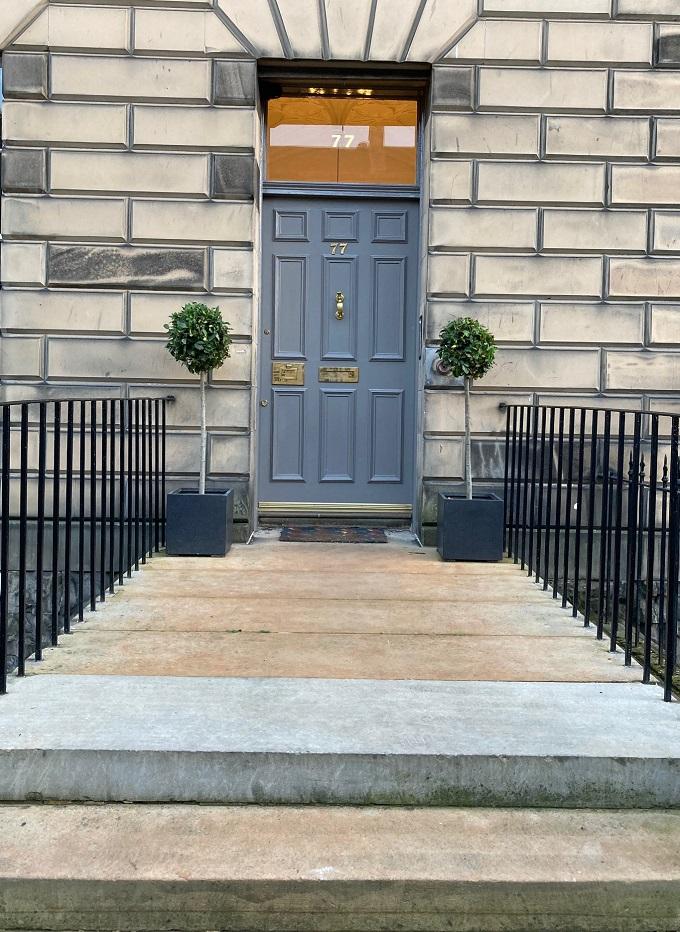
Image of 77 Great King Street, New Town, Edinburgh, September 2022
Crown copyright, NRS
Ten years later, we discover McLagan in the 1851 census for Mid Calder. The 1851 census provides more information than the 1841 census. McLagan is enumerated as Peter McLagan Jr, Head of the household of Pumpherston Farm. He is unmarried, aged 28, and a ‘Farmer of 400 [acres] employing 30 labourers & 6 masons’. His birthplace is given as Demerara. Also in his household, are three servants: Jessie Thomson, aged 22, a house maid; Elizabeth Patterson, aged 39, a cook; and David Wardlaw, aged 14, a groom.

Detail of Peter McLagan and his household’s entry in the 1851 census for Mid Calder, Midlothian.
Crown copyright, NRS, 1851/694/4/2, page 2
McLagan’s father died, aged 85, ‘of desease of heart some years’ on 11th April 1860 and was buried at New Calton Cemetery in Edinburgh. He is recorded as a ‘Landed Proprietor’ and 'widower'. His parents were John McLagan and Grace McInrey. At the time of his death, he was still resident at 77 Great King Street. McLagan was the informant of his father’s death and was living at Pumpherston in Mid Calder.

Detail of Peter McLagan’s [McLagan’s father] death entry in the statutory register for Edinburgh, 11th April 1860.
Crown copyright, NRS, 1860/685/2/216
McLagan was well provided for in his father’s will and inherited Pumpherston estate, a rich mineral field. (NRS, SC70/4/70, pp. 365-403.)
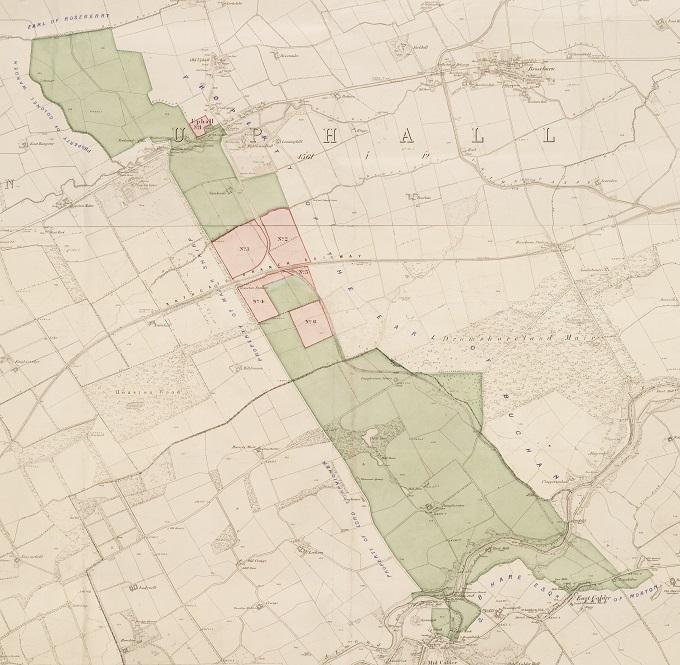
Detail from plan marked to show the entailed lands and estates of Pumpherston, Broadyetts, Fortneuck and others, the properties of Peter McLagan MP, with adjoining landowners named, 1867.
Crown copyright, NRS, RHP46746.
You can consult an image of RHP46746 for free using the maps and plans search on Scotland's People. (Please note, you will need to log into your Scotland's People account in order to view it.)
In the 1865 General Election, McLagan stood as the candidate for his local Liberal association, as the MP for Linlithgowshire, and was elected unopposed as Scotland’s first black MP. He was also re-elected at the next six general elections, and as such, was the longest serving Scottish MP during the reign of Queen Victoria. These were two astonishing achievements for a person of colour at that time.
As an MP, he was an advocate of the Temperance cause but also held views which were less conventional for the time. He supported women’s suffrage, the Irish Home Rule Movement, and called for the establishment of the Scottish Office. He also supported primary and secondary education and that all children should have access to the same level of education which should be non-denominational.
On 8th August 1876, McLagan married Elizabeth Ann Taylor (1846-1882), at St James’ Church, Piccadilly, Westminster in London. In 1878, Taylor presented a water fountain to Bathgate in West Lothian, (in McLagan’s constituency), to mark the town council securing a reliable source of clean drinking water for the town. The water feature is popularly known as ‘McLagan’s fountain’.
McLagan invested in the production of shale oil but was declared bankrupt in 1893. Consequently, he was unable to continue as an MP and resigned his seat on 2nd June 1893 by becoming Steward of the Manor at Northstead.
McLagan died aged 77 at Marylebone in London. His death and achievements as an MP were widely reported in contemporary newspapers. The Linlithgowshire Gazette's obituary of McLagan said 'he had lived so he died - an upright, an honourable and an honest man.' (Linlithgowshire Gazette, Friday 7th September 1900.)
On the day of his funeral in Mid Calder, West Lothian, the local schools were closed and businesses suspended as a mark of respect. The funeral procession was one of the largest ever seen in the parish, and attended by McLagan's relatives, personal friends, clergy from neighbouring parishes, and the general community. He is buried with his wife, (who had died in 1882), in the churchyard of Kirk of Calder. Their elaborate gravestone, which features an image of his wife, is the only known memorial to Scotland’s first, and to date, only black MP.
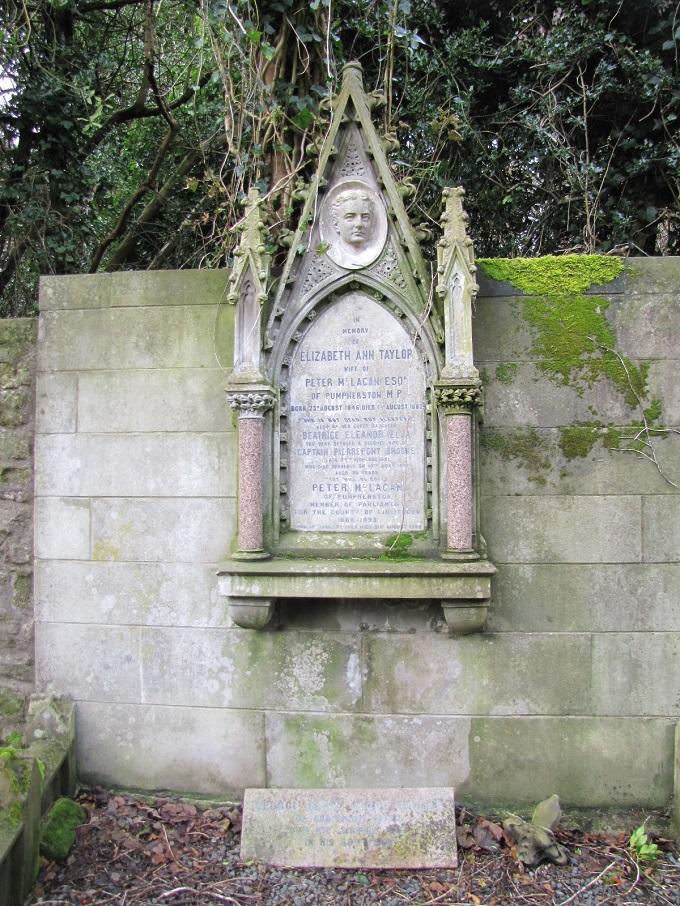
Image of the gravestone of Peter McLagan MP, Kirk of Calder, Mid Calder, West Lothian, nd.
The gravestone features an image of McLagan’s wife, Elizabeth Ann Taylor.
Image credit: Scotland Monumental Inscriptions record set, Find My Past
Acknowledgements
With thanks to The British Newspaper Archive for permission to quote from the Linlithgowshire Gazette.
Further reading
David Alston’s Slaves and Highlanders website [Accessed September 2022]
Alison Campsie, “Memorial calls for Scotland’s ‘forgotten’ first non-white MP” [Accessed September 2022]
Hansard 1803-2005, Contributions in Parliament made by Peter McLagan [Accessed October 2022]
Legacies of British Slavery database [Accessed September 2022]
David William Main, ‘The remarkable career of Peter McLagan MP’, History Scotland, 10 April 2021. [Accessed September 2022]